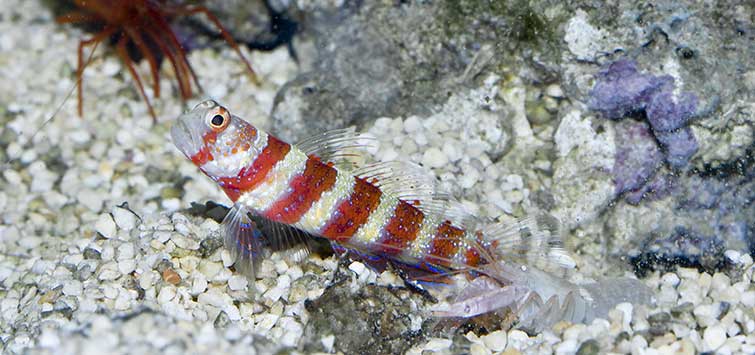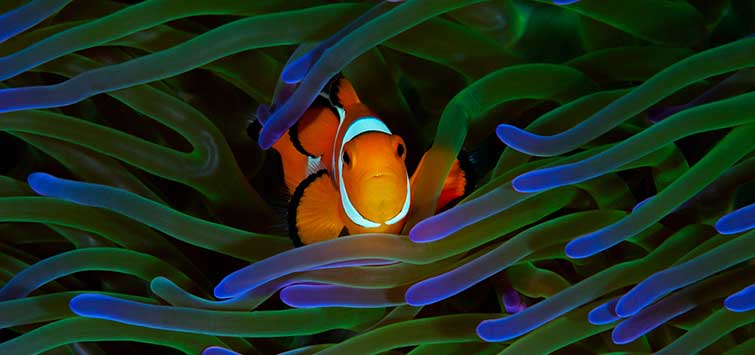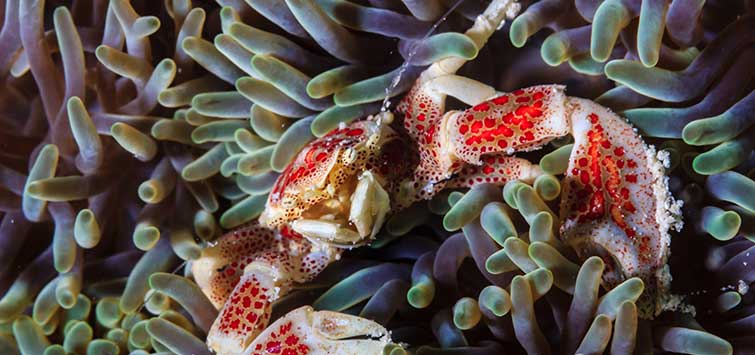Pistol Shrimps and Gobies: Perfect Partners
Author: Phil Hunt
An expert marine fishkeeper examines the fascinating symbiotic relationship between pistol shrimps and the gobies they partner with in the reef aquarium.
Surprising Characteristics
Many of the creatures that we keep in our aquariums have unexpected features, but there are probably few that can compete in this respect with pistol shrimps, or snapping shrimps, as they are also known. While their commensal relationships with gobies are remarkable enough (and are the main focus of this article), they can lay claim to two much more remarkable things.
Gunshot Noise
First is the noise they make, a popping sound that is quite like a gunshot, which gives them their common name. The sound is slightly alarming to hear in the aquarium, as it sounds similar to cracking glass. The main feature of the pistol shrimp’s noise, however, is that it is very, very loud. Some species of pistol shrimps rival whales for the accolade of noisiest creature in the ocean—pretty impressive given the size difference! To quantify the sound, the intensity has been measured as 190 decibels at 3 feet (1 meter) from the shrimp: louder than a jet engine 165 feet away.
Bubble Noise
All the more remarkable is that the sound may be just a side effect of the shrimp’s feeding technique. Pistol shrimps use a specially adapted claw to fire a pulse of water at their prey; the water shoots out of the claw at around 62 miles (100 km) per hour. In its wake, the water leaves a tiny bubble, and the sound is generated as this bubble collapses. The whole process lasts less than a millisecond. It’s unclear whether it’s the water pulse, the sound, or a pressure wave generated by the collapsing bubble that actually stuns or kills the shrimp’s prey.
As Hot as the Sun
The sound is impressive, but something else about the pistol shrimp’s shot is positively mind-blowing. Using high-speed cameras to film pistol shrimps in action, scientists observed that a flash of light is also emitted as the tiny bubble in the wake of the pulse of water collapses. This is weird enough in itself, but what it indicates is that the tiny collapsing bubble reaches a temperature of almost 9000oF (almost 5000oC)—not far from the temperature of the surface of the sun. This is probably the highest temperature that can be achieved by any living organism. The event is so brief and the bubble so small that the shrimp doesn’t cook itself, but it’s astonishing to think that a small crustacean can generate such temperatures.
Perfect Partners
The partnership between pistol shrimps and gobies is a good example of commensalism, where both parties in the relationship benefit. The goby benefits from the shrimp's digging and construction skills, having access to a well-built burrow. Pistol shrimps have poor eyesight, and they use gobies as an early warning system to detect predators.
Gobies tend to hover just outside the shared burrow, catching passing zooplankton or small benthic invertebrates. In many cases the shrimps maintain contact with the gobies by using their long antennae, and the gobies signal to the shrimps using specific fin flicks. Some species of goby also appear to feed their shrimps, spitting food into the burrow, and even without such deliberate actions it's possible that the shrimps may feed on fragments of food that the gobies drop.
Meet the Gun-Slinging Shrimps
A. bellulus
While many species of pistol shrimps are found in a wide variety of habitats, only a few are commonly kept in aquariums. These are species of the genus Alpheus. A. bellulus, also known as the tiger pistol shrimp, is perhaps the most frequently kept species. It has a white body with complex brown or reddish-brown markings. Some individuals have purple markings on the legs.
A. randalli
A. randalli is similar, but rather than the intricate markings of A. bellulus it has irregular red bands along the body and claws. Both associate well with many different goby species. Another very attractive, but less often imported, species is the golden pistol shrimp (often referred to as A. ochrostriatus in the trade, but currently has no scientific name), which has a yellow body and claws with faint longitudinal stripes and a white band at the rear of the thorax.
A. soror
One other Alpheus pistol shrimp deserves a mention, A. soror, the bull’s-eye shrimp. This shrimp generally doesn’t associate with gobies, but it is an attractive species in its own right, with an orange-pink body with prominent black ocelli on either side of the anterior part of the tail, and purple claws.
The commonly imported Alpheus species typically grow to 2 to 2¾ inches (5 to 7 cm). There are other Alpheus species, and other pistol shrimps, that find their way into aquarium stores, but they are often of unknown species.
And Their Goby Guests
Several genera of gobies associate with pistol shrimps. They can be (and usually are) kept without shrimps, and most are good aquarium fishes in their own right. They are generally hardy and easy to feed, but many (even the robust-looking Cryptocentrus gobies) can be quite shy, and they are prone to jumping from open aquariums or even through gaps in aquarium covers. They often seem to be both bolder and less prone to jumping when kept with shrimps—perhaps having an expertly constructed bolt-hole close at hand makes them more confident.
Their initial shyness can be an issue when getting them to feed when they’re first introduced into the aquarium, as they may be reluctant to venture out to take food, especially in busy tanks with fast-moving or aggressive fishes. To overcome this, make sure that some food drifts past their hiding place (e.g., by squirting some food just upstream of the goby’s lair with a turkey baster or pipette) so that they get enough to eat in the short term, and eventually they will come to associate humans with being fed and become bolder.
Common Aquarium Species
The most common aquarium imports are species of Amblyeleotris, Cryptocentrus, and Stonogobiops, although other species are sometimes offered for sale. There are 38 species of Amblyeleotris, which in the wild associate with a variety of Alpheus shrimps. Many of them look quite similar: long, slender fishes that are white with dark red bands, most growing to 4 to 5 inches (10 to 12.5 cm). There are some more distinctive species in this genus, notably Randall's shrimp goby (A. randalli), which is white with thin orange bands and has a large dorsal fin with a prominent black ocellus (eye-spot). Also distinctive, if seldom seen in aquariums, is the giant shrimp goby (A. fontanesii), which looks similar to most other Amblyeleotris species except in terms of size—this species lives up to its common name by potentially growing to 10 inches (25 cm).
Stonogobiops Gobies
The Stonogobiops gobies are at the opposite end of the size scale; the largest of the currently known species grows to only 2¾ inches (7 cm), and most are smaller than this. Four species are seen relatively frequently in the aquarium trade: S. dracula, (the largest species), which has a yellow face and white body with alternating thick and thin dark-red bands; S. nematodes, which grows to 2¼ inches (5.7 cm) and has a brown-banded white body, yellow face, and very elongated first dorsal fin ray; the 2¼-inch S. xanthorhinica, which looks similar to S. nematodes but lacks the elongated dorsal fin ray; and the 2-inch (5-cm) S. yasha, a very distinctive goby, white with bright red longitudinal stripes and a very long first dorsal ray. Stonogobiops species usually associate with Alpheus shrimps, particularly A. randalli.
Cryptocentrus Species
Cryptocentrus species have a more robust look than most other shrimp gobies, with frog-like heads and big mouths. They tend to be more aggressive towards related species, and in the case of the larger species even towards other tankmates, than other shrimp gobies. Not many of the 34 species find their way into the aquarium trade with any frequency. The most popular species is the yellow watchman goby (C. cinctus), which grows to 4 inches. One larger species is also fairly common in dealers’ tanks: C. leptocephalus, the pink-spotted shrimp goby. It grows to around 6 inches (15 cm) and is grayish but with bright pink spots and blotches as well as smaller neon-blue spots.
Numerous other Cryptocentrus species are occasionally offered for sale, and while relatively little is known about their care, they can probably be expected to behave in a similar way to their more familiar congeners. In the wild, Cryptocentrus associate with a variety of Alpheus shrimps.
Creating a Home for Gobies and Shrimps
When keeping pistol shrimps and gobies, the main area of concern is what the shrimp will do to the aquarium. Pistol shrimps have one preoccupation: constructing and maintaining elaborate burrows. This in itself makes them very interesting and entertaining aquarium inhabitants, even without gobies, but it does need to be taken into consideration when setting up the tank.
Substrate
The first requirement is to make sure that any rocks are securely positioned on the base of the tank—neither sitting on top of the sand or gravel substrate nor leaning on it. Pistol shrimps can easily undermine rocks when digging, leading to potentially tank-breaking landslides.
To provide your shrimp with an ideal environment for building burrows, use a mixed-bed substrate of sand and coarse coral gravel (¼- to ¾-inch [0.5- to 2-cm] fragments of coral branches). A deeper bed is best, but about 3 inches (8 cm) will do. Shrimps usually use a mixture of sand, gravel, shells, and small rocks to construct burrows, and it’s fascinating to watch them carefully arranging and then repositioning individual pieces.
It’s important not to underestimate the effects of even a small shrimp on the substrate-level aquascape: Corals sitting on the sand may be buried, or if small enough (frags, for example) carried off and used as building material. In my large reef tank a small pistol shrimp occupies an area of about 15 x 15 inches (38 x 38 cm), within which only large rocks are safe. If you keep a pistol shrimp in a nano aquarium, you need to be ready to let the shrimp use the entire substrate as it will to make its home; that doesn’t mean that you can’t create an aquascape using rocks, but you need to make sure the rocks are well secured to the tank base. The shrimp will work around them.
Acclimation
Apart from their desire for plentiful supplies of building materials, pistol shrimps are generally less demanding in the aquarium than many other crustaceans. Like other types of shrimp, they should have a slow, careful acclimation when first added to the tank, but once established they seem to be rather hardier than, for example, cleaner or peppermint shrimps. They seem to be more tolerant of salinity and temperature swings.
Feeding
Feeding pistol shrimps is easy. They will eat frozen crustaceans (Artemia, krill, mysid shrimp, and copepods) as well as hunt their own food.
Tankmates
A certain amount of care is required when it comes to choosing crustacean tankmates for pistol shrimps. Large pistol shrimps (although not the species generally kept with gobies) are fairly formidable mini-predators and can easily capture and kill smaller aquarium shrimps such as Lysmata, Thor, and Rhynchocinetes species. Smaller ones, however, despite their snapping claws, are vulnerable to predation when molting, which, like other shrimps, they do regularly in order to grow.
Immediately after molting, their new shell is very soft and provides little protection. At this stage they are easy prey for larger shrimps such as Stenopus species. Even large peppermint shrimps (Lysmata wurdemanni), which lack large claws, can be surprisingly predatory and will eat small pistol shrimps. In large tanks such predation is less of an issue, but in nano aquariums it is best to keep your pistol shrimp as the only shrimp in the tank.
Choosing Gobies
While pistol shrimps of all kinds can be housed in similar tanks, the size range of goby partners is so varied (from under 2 inches [5 cm] for some Stonogobiops to around 10 inches [25 cm] for the largest Amblyeleotris species) that it's important to choose an appropriate aquarium to suit the fish half of the partnership.
Shrimp gobies of all kinds, especially when teamed up with shrimps, are relatively sedentary, seldom moving far from their burrows, so they can be kept in smaller tanks than their size would suggest. Stonogobiops species in particular are ideal for nano reef aquariums, where the lack of larger fishes enables them to feel more confident and be more extroverted than they typically are in larger systems.
Getting Them Together
If you want to keep pistol shrimps and gobies together, by far the best thing to do is buy them together. That way you can be sure to get a shrimp that is compatible with your goby and be sure that the goby and shrimp will find each other and continue their relationship in the aquarium. Ideally, you should acclimate the shrimp and goby in the same bag or vessel so that they don't lose contact when added to the tank. Best of all is to buy pairs of both shrimps and gobies together, thus replicating the wild situation, but opportunities to do this are rare.
Get the Right Species
Getting gobies and shrimps that have been bought separately to team up is a trickier business. There is one obvious issue, which is that you might not have the right species of shrimp. While many shrimp gobies will partner with different shrimp species, there’s no telling which shrimp an individual goby may have been associated with before it was captured, or how willing it will be to associate with a different species.
Put Them in Together
On a more practical level, shrimps and gobies can have a hard time finding each other if they are introduced to the aquarium separately. The shrimps are obsessed with their burrows, spending a lot of time inside them (even more so when they have no goby partner) and have such poor eyesight that they would be unable to spot a potential burrowmate even a few inches away. For their part, gobies are concerned mainly with food and shelter, and if they find or dig another hole or cave before locating the one holding the shrimp, they will tend to stay there. I once had a Stonogobiops yasha goby living in the same nano tank, with a base area of 14 x 14 inches (36 x 36 cm), as an Alpheus ochrostriatus pistol shrimp for several months without their finding each other.
One way of getting shrimps and gobies together is to force the issue by catching both and putting them together, even briefly, in a bucket, small tank, or even a plastic bag. This was how I eventually got my yasha goby and its shrimp tankmate to find each other, when I was doing a revamp of the nano tank.
If you do this you need to observe both parties carefully and separate them if you see aggressive or territorial behavior. If all goes well, you should be able to observe the two of them staying close together, often with the shrimp keeping at least one of its antennae in contact with the goby. The two can then be re-introduced to the aquarium, and if they have bonded they should stay together.
As the process of catching both parties, but especially the shrimp, is likely to cause some disruption in the aquarium, this method is best used when rearranging tank dÉcor or otherwise changing the aquarium setup. It is also something that you could do having just bought either shrimp or goby when you have the other half of the team already in residence. The new arrival should be acclimated carefully to the aquarium water, in a shipping bag or other vessel, then the resident should be introduced to it, prior to both being added (or, in the case of the resident, returned) to the main aquarium.
See the full article on TFH Digital http://www.tfhdigital.com/tfh/october_2014#pg75

.png?h=595&iar=0&w=2781&hash=5FD5E69473BCC22199FBFA2FB71B6033)



